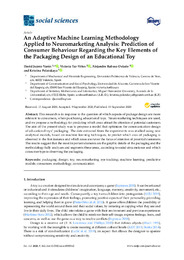Por favor, use este identificador para citar o enlazar este ítem:
https://hdl.handle.net/11000/34516Registro completo de metadatos
| Campo DC | Valor | Lengua/Idioma |
|---|---|---|
| dc.contributor.author | Juárez-Varón, David | - |
| dc.contributor.author | Tur-Viñes, Victoria | - |
| dc.contributor.author | Rabasa, Alejandro | - |
| dc.contributor.author | Polotskaya, Kristina | - |
| dc.contributor.other | Departamentos de la UMH::Estadística, Matemáticas e Informática | es_ES |
| dc.date.accessioned | 2025-01-15T19:33:45Z | - |
| dc.date.available | 2025-01-15T19:33:45Z | - |
| dc.date.created | 2020-09 | - |
| dc.identifier.citation | Social Sciences Volume 9 Issue 9 | es_ES |
| dc.identifier.issn | 2076-0760 | - |
| dc.identifier.uri | https://hdl.handle.net/11000/34516 | - |
| dc.description.abstract | This research is in response to the question of which aspects of package design are more relevant to consumers, when purchasing educational toys. Neuromarketing techniques are used, and we propose a methodology for predicting which areas attract the attention of potential customers. The aim of the present study was to propose a model that optimizes the communication design of educational toys’ packaging. The data extracted from the experiments was studied using new analytical models, based on machine learning techniques, to predict which area of packaging is observed in the first instance and which areas are never the focus of attention of potential customers. The results suggest that the most important elements are the graphic details of the packaging and the methodology fully analyzes and segments these areas, according to social circumstance and which consumer type is observing the packaging | es_ES |
| dc.format | application/pdf | es_ES |
| dc.format.extent | 23 | es_ES |
| dc.language.iso | eng | es_ES |
| dc.publisher | MDPI | es_ES |
| dc.rights | info:eu-repo/semantics/openAccess | es_ES |
| dc.rights | Attribution-NonCommercial-NoDerivatives 4.0 Internacional | * |
| dc.rights.uri | http://creativecommons.org/licenses/by-nc-nd/4.0/ | * |
| dc.subject | packaging | es_ES |
| dc.subject | design | es_ES |
| dc.subject | toy | es_ES |
| dc.subject | neuromarketing | es_ES |
| dc.subject | eye tracking | es_ES |
| dc.subject | machine learning | es_ES |
| dc.subject | predictive models | es_ES |
| dc.subject | consumers | es_ES |
| dc.subject | methodology | es_ES |
| dc.subject | communication | es_ES |
| dc.subject.other | CDU::5 - Ciencias puras y naturales::50 - Generalidades sobre las ciencias puras | es_ES |
| dc.title | An Adaptive Machine Learning Methodology Applied to Neuromarketing Analysis: Prediction of Consumer Behaviour Regarding the Key Elements of the Packaging Design of an Educational Toy | es_ES |
| dc.type | info:eu-repo/semantics/article | es_ES |
| dc.relation.publisherversion | https://doi.org/10.3390/socsci9090162 | es_ES |

Ver/Abrir:
_8 Neuromarketing.pdf
10,78 MB
Adobe PDF
Compartir:
 La licencia se describe como: Atribución-NonComercial-NoDerivada 4.0 Internacional.
La licencia se describe como: Atribución-NonComercial-NoDerivada 4.0 Internacional.
.png)